Canon MP210 User Manual
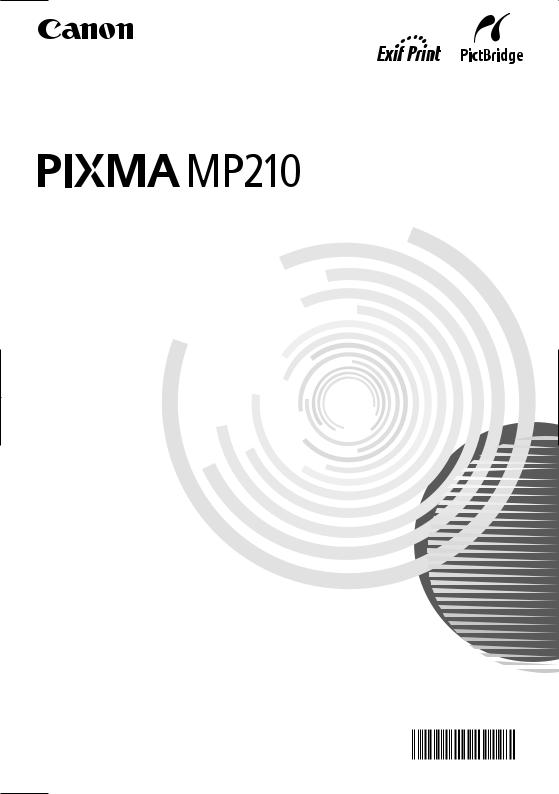
Photo All-in-One
series
Quick Start Guide
Q T 5 1 2 0 8 V 0 1
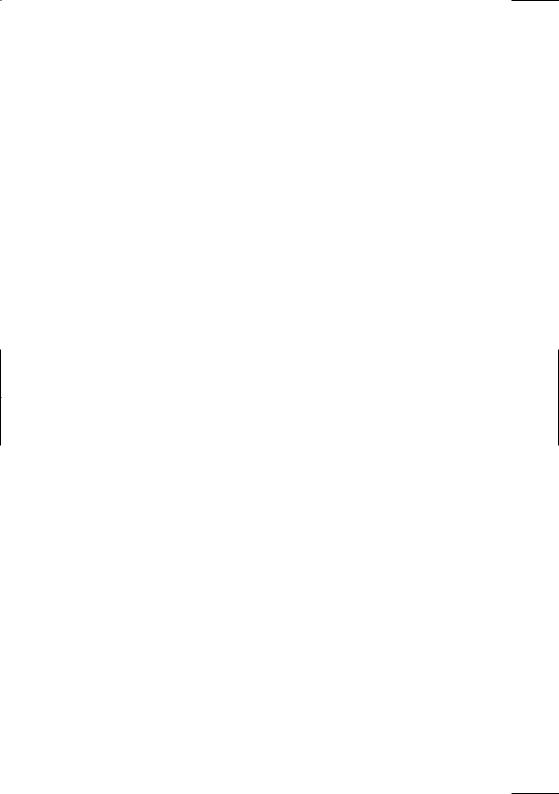
Getting Help from Canon
Help Us Help You Better
Before you contact Canon, please record the following information.
Serial Number (located on the inside of the product): _____________________________________
Model Number (located on the top of the product): _______________________________________
Setup CD-ROM number (located on the CD-ROM): ______________________________________
Purchase Date: __________________________________________________________________
Customer Technical Support Sequence*
1.Internet — www.canontechsupport.com
For quick and comprehensive self-help in an intuitively guided interactive troubleshooting environment, the place to start is our helpful tech support web site. In addition, the latest driver downloads, answers to frequently asked questions, product information, and “where to buy” instructions are found here.
2.Email Tech Support — www.canontechsupport.com
For individual attention to a special issue, try emailing our friendly technical support representatives, specially trained to communicate quick, easy, and logical solutions to your inquiries within 24 hours.
3.Toll-Free Live Tech Support — (1-800-828-4040)
This option provides live telephone technical support, free of service charges, MondaySaturday (excluding holidays), during your product’s 90 day limited warranty period. Telephone Device for the Deaf (TDD) support is available at (1-866-251-3752).
4.Extended Service and Support — www.canonesp.com
Canon CarePAK Extended Service Plan is a cost-attractive and easy-to-use extended service program that provides up to three full years of service and support coverage at a very attractive price. CarePAK offers toll-free Canon technical support and includes Canon’s superb InstantExchange product replacement program. For further information about extending your Canon service and support, call (1-800-385-2155), or visit our Web site at www.canonesp.com. CarePAK must be purchased during your product’s warranty period.
For more information and updated program specifics, please visit our web site at www.canontechsupport.com.
* Support program specifics are subject to change without notice.
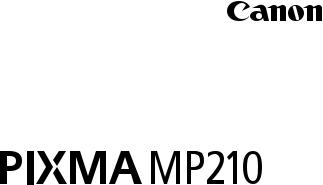
series
Photo All-in-One
Quick Start Guide

Canon PIXMA MP210 series Photo All-in-One Quick Start Guide.
Copyright
This manual is copyrighted by Canon U.S.A., Inc. with all rights reserved. Under the copyright laws, this manual may not be reproduced in any form, in whole or in part, without the prior written consent of Canon U.S.A., Inc.
© 2007 Canon U.S.A., Inc.
Disclaimer
Canon U.S.A., Inc. has reviewed this manual thoroughly in order that it will be an easy-to-use guide to your Canon PIXMA MP210 series Photo All-in-One. All statements, technical information and recommendations in this manual and in any guides or related documents are believed reliable, but the accuracy and completeness thereof are not guaranteed or warranted, and they are not intended to be, nor should they be understood to be, representation or warranties concerning the products described.
Specifications are subject to change without notice.
As an ENERGY STAR® Partner, Canon Inc. has determined that this product meets the ENERGY STAR® guidelines for energy efficiency.
All information regarding non-Canon products was compiled from publicly available information. No representation is made regarding the accuracy thereof.
About Consumables
Consumables (ink tanks / FINE Cartridges) are available for 5 years after production has stopped.
Trademarks
z“Microsoft” is a registered trademark of Microsoft Corporation.
z“Windows” is a trademark of Microsoft Corporation, registered in the U.S. and other countries.
z“Windows Vista” is a trademark of Microsoft Corporation.
z“Macintosh” and “Mac” are trademarks of Apple Inc., registered in the U.S. and other countries.
Canon U.S.A., Inc.
One Canon Plaza
Lake Success, NY 11042

Table of Contents |
|
Before Using the Machine ............................. |
2 |
Operation Panel.............................................. |
2 |
Turning the Machine On and Off .................... |
4 |
Handling the Original Document..................... |
6 |
Loading Printing Paper ................................... |
7 |
Copying ......................................................... |
15 |
Making Copies.............................................. |
15 |
Changing the Copy Settings......................... |
16 |
Using Useful Copy Functions ....................... |
16 |
Printing from Your Computer...................... |
17 |
Printing with Windows................................... |
17 |
Printing with Macintosh................................. |
18 |
Scanning Images.......................................... |
19 |
Scanning Methods........................................ |
19 |
Printing Photographs Directly from |
|
a Compliant Device ................................ |
20 |
Printing Photographs Directly from |
|
a Compliant Device....................................... |
20 |
About PictBridge Print Settings..................... |
22 |
Routine Maintenance ................................... |
25 |
List of Maintenance Codes ........................... |
25 |
When Printing Becomes Faint or Colors |
|
Are Incorrect ................................................. |
26 |
Printing the Nozzle Check Pattern................ |
27 |
Examining the Nozzle Check Pattern ........... |
28 |
Print Head Cleaning...................................... |
29 |
Print Head Deep Cleaning............................ |
30 |
Aligning the Print Head................................. |
31 |
Replacing a FINE Cartridge.......................... |
33 |
Keeping the Best Printing Results ................ |
39 |
Cleaning Your Machine ................................ |
40 |
Troubleshooting ........................................... |
43 |
An Error Code Is Displayed on the LED ....... |
44 |
LED Cannot Be Seen At All.......................... |
46 |
Cannot Install the MP Drivers....................... |
46 |
Cannot Connect to Computer Properly......... |
47 |
Print Results Not Satisfactory....................... |
48 |
The Print Result Not Satisfactory When |
|
Copying......................................................... |
52 |
Printing Does Not Start ................................. |
52 |
Paper Does Not Feed Properly..................... |
53 |
Paper Jams................................................... |
54 |
Error Message Appears on the Computer |
|
Screen .......................................................... |
55 |
Error Message Appears on a PictBridge |
|
Compliant Device.......................................... |
57 |
Scanning Problems....................................... |
58 |
Appendix ....................................................... |
59 |
How to Use the Documentation Provided..... |
59 |
Reading the On-screen Manuals.................. |
60 |
Specifications................................................ |
61 |
Safety Precautions....................................... |
64 |
Legal Limitations on Use of Your Product |
|
and Use of Images ....................................... |
67 |
Users in the U.S.A. ....................................... |
68 |
Index.............................................................. |
72 |
1
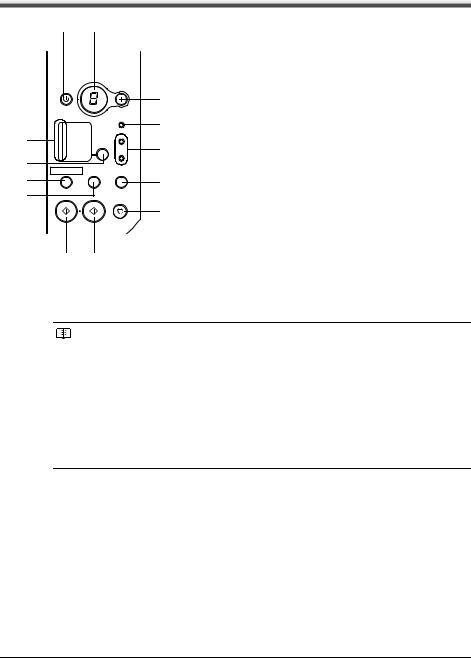
Before Using the Machine
Operation Panel
(1)(2)
|
(3) |
|
|
(4) |
|
(13) |
(5) |
|
(12) |
||
|
||
(11) |
(6) |
|
(10) |
|
|
|
(7) |
(9)(8)
(1)ON/OFF button / Power lamp
Turns the machine on and off. Lights or flashes green to indicate the power status. Before turning on the machine, make sure the Document Cover is closed.
Note
Power Lamp and Alarm Lamp
You can check the status of the machine by the Power and Alarm lamps.
zPower lamp Off: The power is off.
zPower lamp lit green: The machine is ready to print.
zPower lamp flashing green: The machine is initializing or shutting down.
zAlarm lamp lit orange: An error has occurred and the machine is not ready to print. For details, see “An Error Code Is Displayed on the LED” on page 44.
zPower lamp flashing green once and Alarm lamp flashing orange once alternately:
An error that requires contacting your Canon Service representative may have occurred.
For details, see “Power Lamp Flashes Green and Alarm Lamp Flashes Orange Alternately” on page 45.
(2)LED (Light Emitting Diode)
Displays the number of copies, Maintenance menu selections or the operational status.
(3)[+] button
Increases the number of copies.
(4)Alarm lamp
Lights or flashes orange when an error, such as paper-out or ink-out, occurs.
(5)Black/Color Ink lamps
Lights or flashes to show the ink status.
(6)SCAN button
Opens the MP Navigator EX to scan a document to your computer according to the settings selected. To use this button, the machine must be connected to a computer. For details, refer to the Scanning Guide on-screen manual.
2 |
Before Using the Machine |
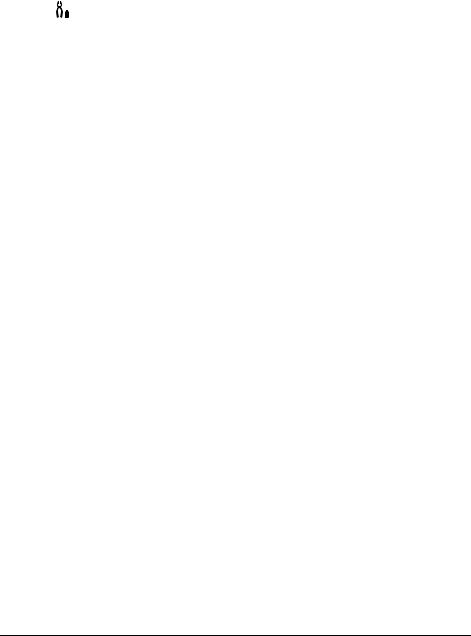
(7)Stop/Reset button
Cancels operations or a print job in progress.
(8)Color button*
Starts color copying. Also, finalizes your selection for the menu or setting item.
(9)Black button*
Starts black & white copying. Also, finalizes your selection for the menu or setting item.
(10) (Maintenance) button
(Maintenance) button
Accesses the Maintenance menu.
(11)Fit to Page button / Fit-to-Page lamp
Enables/disables the Fit-to-Page copying. Lights when Fit-to-Page copying is enabled.
(12)Paper button
Switches the page size and media type for copying.
For information on how to switch the page size between A4 and Letter, see “Setting The Default Page Size” on page 16.
(13)Paper lamp
Displays the selected page size and media type for copying.
*In the software applications or manuals, the Black and Color buttons are collectively called the “Start” or “OK” button.
Before Using the Machine |
3 |
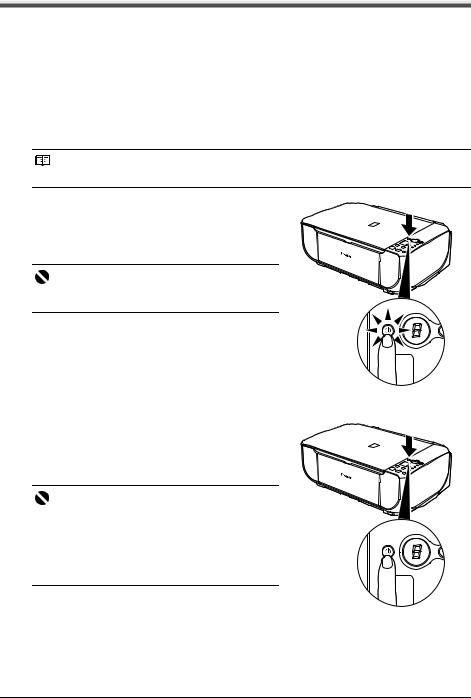
Turning the Machine On and Off
Turn on the machine before printing.
Turning on the Machine
Before turning on the machine, confirm the following. z The FINE Cartridges are installed properly.
If you are using the machine connected to a computer, confirm also the following.
zThe machine is connected to your computer (or a compatible device).
zThe MP Drivers are installed.
Note
If preparatory operations above are not complete, follow your setup sheet to complete them.
1 Press the ON/OFF button to turn on the machine.
The Power lamp flashes and then remains lit green.
Important
If the Alarm lamp begins to flash orange, see “An
Error Code Is Displayed on the LED” on page 44.
2 If you are using the machine connected to a computer, turn on your computer.
Turning off the Machine
1 To turn off the machine, press the ON/OFF button.
When the Power lamp stops flashing, the machine is turned off.
Important
About the Power Plug
When removing the power plug after turing off the machine, be sure to confirm that the Power lamp is not lit. If the power plug is removed from the wall outlet with the Power lamp still lit or flashing green, the machine may become unable to print.
See “Keeping the Best Printing Results” on page 39.
4 |
Before Using the Machine |
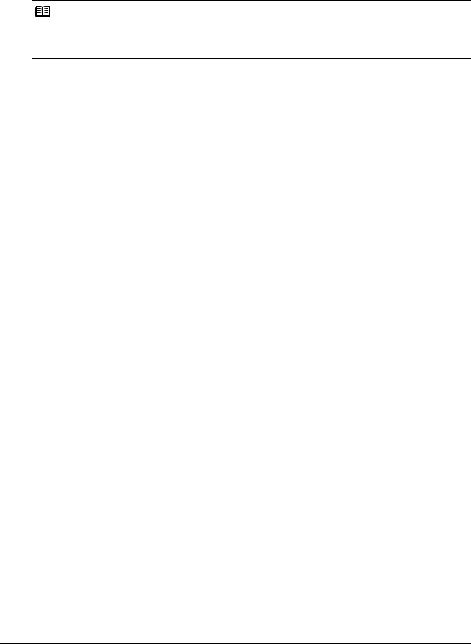
z Screen-saver Mode
The LED goes out if the machine is not operated for about five minutes*. Perform a print operation to restore the display.
* You cannot change the wait time before the LED goes out.
Note
When you want to restore the display, perform a print operation or press any button except for the ON/OFF button. When you press the ON/OFF button while the machine is in Screen-saver mode, the machine turns off.
Before Using the Machine |
5 |
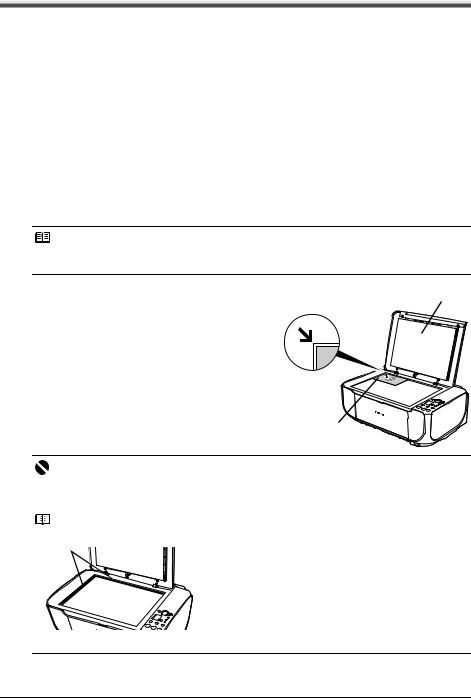
Handling the Original Document
This section describes how to load the original document on the Platen Glass.
Original Document Requirements
The original documents you load on the Platen Glass for copying or scanning must meet these requirements:
Document type |
z Paper documents |
|
z Photographs |
|
z Books |
Size (W x L) |
Max. 8.5 x 11.7 inches / 216 x 297 mm |
Thickness |
Max. 0.6 inches / 15 mm |
Loading Original Documents
Load originals to copy or scan on the Platen Glass.
Note
Make sure any glue, ink, correction fluid, or the like on the original document is completely dry before loading it on the Platen Glass.
1 Load the original document on the Platen |
(1) |
Glass. |
|
(1) Lift the Document Cover.
(2) Load the original with the side to be copied/ scanned facing down on the Platen Glass. Place the original in landscape orientation and align the upper corner of it with the alignment mark as shown in the figure on the right.
(2)
Important
zDo not place any objects weighing more than 4.4 lb / 2 kg on the Platen Glass.
zDo not press or put weight on the original with pressure exceeding 4.4 lb / 2 kg. Doing so may cause the scanner to malfunction or the Platen Glass to break.
Note
The machine cannot scan the shaded area in the figure below.
(A)
(A)0.04 inches / 1 mm
2 Gently close the Document Cover.
6 |
Before Using the Machine |
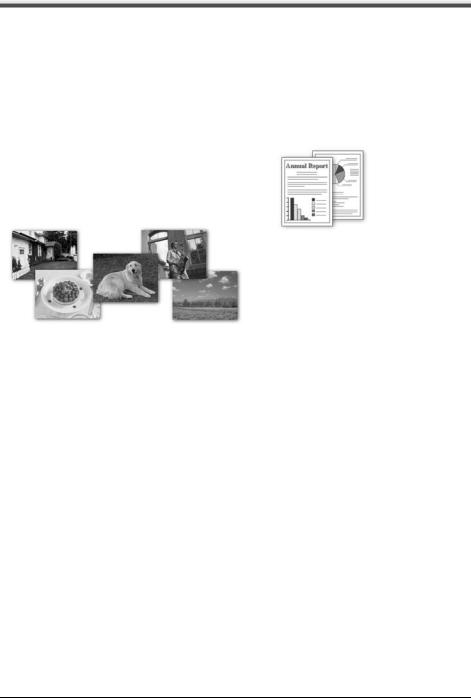
Loading Printing Paper
This section describes how to load printing paper in the Rear Tray.
Using Specialty Media
Canon recommends that you use Canon genuine media to ensure optimal print quality.
z Photo Quality Media |
z Media Suited for Business |
z Glossy Photo Paper |
Documents |
z Matte Photo Paper |
z High Resolution Paper |
zPhoto Paper Plus Double Sided
zPhoto Paper Plus Glossy
zPhoto Paper Plus Semi-gloss
zPhoto Paper Pro
zPhoto Stickers
Before Using the Machine |
7 |

Paper Handling
z Recommended Paper and Requirements
Media Type |
Model*1 |
Paper |
Paper |
Paper |
Printer Driver |
|
|
Support Load |
Output Tray |
Thickness |
Setting for Media |
|
|
Limit |
Load Limit |
Lever*2 |
Type |
Plain Paper*3 |
— |
100 sheets |
50 sheets |
Left |
Plain Paper |
Envelopes*4 |
— |
10 envelopes |
1 envelope |
Right |
Envelope |
High Resolution |
HR-101N |
80 sheets |
50 sheets |
Left |
High Resolution |
Paper*4 |
|
|
|
|
Paper |
Super White Paper |
SW-201 |
80 sheets |
50 sheets |
Left |
Plain Paper |
|
|
|
|
|
|
Glossy Photo |
GP-401 |
A4, Letter, 5" x |
*6 |
Left |
Glossy Photo Paper |
Paper*5 |
|
7" / 127.0 x |
|
|
|
|
|
177.8 mm and |
|
|
|
Glossy Photo Paper |
GP-501 |
|
Left |
Glossy Photo Paper |
|
“Everyday Use”*5 |
|
8" x 10" / |
|
|
|
|
|
203.2 x 254.0 |
|
|
|
Matte Photo Paper |
MP-101 |
|
Left |
Matte Photo Paper |
|
mm: 10 sheets |
|
||||
Photo Paper Glossy |
GP-502 |
|
Left |
Glossy Photo Paper |
|
4" x 6" / 101.6 |
|
||||
Photo Paper Plus |
SG-101, |
|
Left |
Photo Paper Plus |
|
x 152.4 mm, |
|
||||
Semi-gloss*5 |
SG-201 |
Wide and |
|
|
Glossy |
Photo Paper Pro*5 |
PR-101 |
Credit card: 20 |
|
Left |
Photo Paper Pro |
|
|
sheets |
|
|
|
Photo Paper Plus |
PP-101 |
|
Left |
Photo Paper Plus |
|
Glossy*5 |
|
|
|
|
Glossy |
Photo Paper Plus |
PP-101D |
1 sheet |
|
Left |
Photo Paper Plus |
Double Sided*4*7 |
|
|
|
|
Double Sided |
Photo Stickers |
PS-101 |
1 sheet |
|
Left |
Photo Paper Plus |
|
|
|
|
|
Glossy |
T-Shirt Transfers*4 |
TR-301 |
1 sheet |
|
Right |
T-Shirt Transfers |
*1 Paper with a Model Number is Canon specialty media. Refer to the instruction manual supplied with the paper for detailed information on the printable side and notes on handling paper. For information on the paper sizes available for each Canon genuine paper, visit our website. You may not be able to purchase some Canon genuine papers depending on the country or region of purchase. Paper is not sold in the US by Model Number. Purchase paper by name.
*2 If the corners or edges of the paper are smudged, try to print with the Paper Thickness Lever set to the right. It may improve print quality.
Reset the Paper Thickness Lever to the left when you finish printing.
For details on the Paper Thickness Lever, refer to “Inside” in “Main Components” of the User’s Guide on-screen manual.
*3 Proper feeding of paper may not be possible at the maximum capacity depending on the type of paper or environmental conditions (either very high or low temperature and humidity). In such cases, reduce the sheets of paper you load at a time to around half (around 0.2 inches / 5 mm in paper stack height).
*4 Available only when printing from your computer.
*5 When loading paper in stacks, the print side may be marked as it is fed in or sheets may be stuck to one another causing them not to be fed properly. In this case, load one sheet at a time.
*6 We recommend that you remove the previously printed sheet from the Paper Output Tray before continuously printing to avoid blurs and discoloration.
8 |
Before Using the Machine |
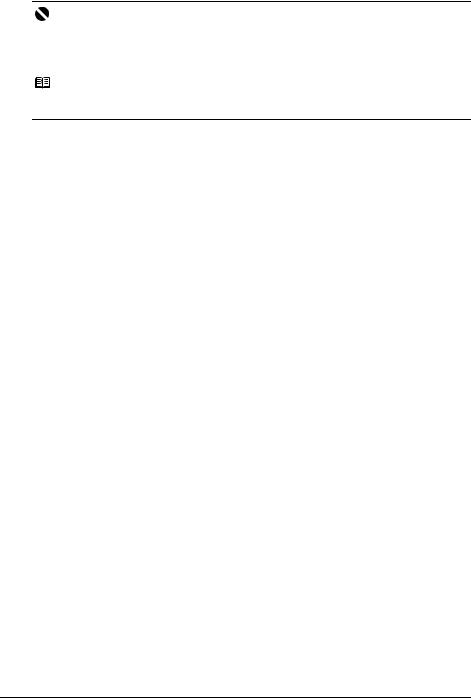
*7 This paper cannot be used in Macintosh®.
Important
zPut unused paper back into the package, and store them avoiding heat, humidity, and direct sunlight.
zDo not touch the printed surface nor stack the printed sheets until the ink is fixed.
zIf you select “Photo Paper” when copying, use the following paper types for best printing results: GP-401, GP-501, GP-502, PP-101, SG-201.
Note
For a detailed description of printing media types, refer to “Printing Media” in the User’s Guide onscreen manual.
z Media Types You Cannot Use
Do not use the following types of paper. Using such paper will not only produce unsatisfactory results, but can also cause the machine to jam or malfunction. Additionally, when printing on A5 or smaller sized paper, do not use paper thinner than a post card, including plain paper or notepad paper cut to a small size.
zFolded, curled, or wrinkled paper
zDamp paper
zPaper that is too thin (weighing less than 17 lb / 64 gsm)
zPaper that is too thick (plain paper, except for Canon genuine paper, weighing more than 28 lb / 105 gsm)
zPicture postcards
zPostcards affixed with photos or stickers
zAny type of paper with holes
zPaper that is not rectangular
zPaper bound with staples or glue
zPaper with adhesives
zPaper decorated with glitter, etc.
Before Using the Machine |
9 |

Loading Paper
Important
zIf you cut plain paper to 4" x 6" / 101.6 x 152.4 mm, 5" x 7" / 127.0 x 177.8 mm, or 2.13" x 3.39" / 54.0 x 86.0 mm (credit card-size) for a trial print, it can cause paper jams.
zYou cannot print on postcards affixed with photos or stickers.
zAlways load paper in portrait orientation (A). Loading paper in landscape orientation (B) can cause the paper to be jammed.
(A) |
(B) |
Note
zWe recommend using genuine Canon photo media when printing photographs. For details on the specialty media Canon provides for use with its various printers, see “Using Specialty Media” on page 7.
When Printing on Plain Paper
zYou can use general copy paper or Canon’s Super White Paper. When printing on both sides, we recommend Canon’s Super White Paper Double-Sided.
Paper size:
–Standard sizes: A4, B5, A5, Letter, and Legal
–Non-standard sizes: 2.13 x 3.39 inches to 8.5 x 23 inches / 54.0 x 86.0 mm to 215.9 x 584.2 mm
Paper weight: 17 to 28 lb / 64 to 105 gsm (non-Canon genuine plain paper)
1 Flatten the four corners of the paper before loading it.
Note
zAlign the edges of paper neatly before loading. Loading paper without aligning the edges may cause paper jams.
zIf paper is curled, hold the opposing curled corners and gently bend them in the opposite direction until the paper becomes completely flat. See “Paper is curled.” on page 51.
zTo avoid curling, handle paper as follows.
–Put unused paper back into the package and keep them on a level surface.
–Take out only the necessary number of sheets from the package, just before printing.
10 |
Before Using the Machine |
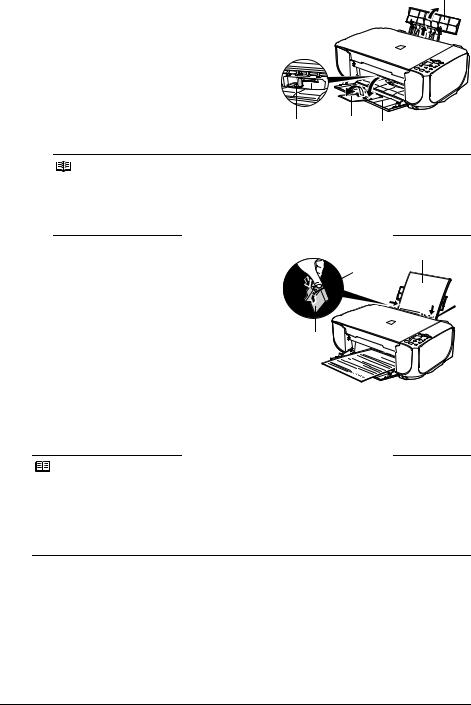
2 Prepare to load paper. |
|
(1) |
|
(1) |
Open the Paper Support, then pull out the |
|
|
|
Paper Support Extension. |
|
|
(2) |
Open the Paper Output Tray. |
|
|
(3) |
Open the Output Tray Extension. |
|
|
(4) |
Adjust the position of the Paper Thickness |
|
|
|
Lever. |
|
|
|
Set it to the right when printing on envelopes |
|
|
|
or T-shirt transfers, and left when printing on |
(4) |
(3) (2) |
|
any other type of paper. See “Paper Handling” |
||
on page 8.
Note
If the corners or edges of the paper are smudged, try to print with the Paper Thickness Lever set to the right. It may improve print quality.
Reset the Paper Thickness Lever to the left when you finish printing.
For details on the Paper Thickness Lever, refer to “Inside” in “Main Components” of the User’s Guide on-screen manual.
3 Load the paper. |
(1) |
|
(1) |
Load the paper in the Rear Tray with the print |
(A) |
|
side facing UP. |
|
(2) |
Align the paper stack against the right side of |
(2) |
|
the Rear Tray. |
|
(3) |
Pinch the Paper Guide and slide it against the |
(3) |
|
left side of the paper stack. |
|
|
|
|
|
|
* Do not load higher than the Load Limit |
|
|
Mark (A). |
4 Specify the page size and media type settings according to the loaded paper.
Note
zWhen performing copy direct printing without using a computer, select the size and type of the loaded paper using the Operation Panel.
For details on settings, see “Making Copies” on page 15.
zWhen using the machine connected to a computer, select the size and type of the loaded paper in Page Size (or Paper Size) and Media Type in the printer driver.
For details on printer driver settings, see “Printing with Windows” on page 17 or “Printing with Macintosh” on page 18.
Before Using the Machine |
11 |

Loading Envelopes
Use either European DL or US Comm. Env. #10-sized envelope.
Important
zYou need to print from the computer to print on envelopes.
zDo not use the following envelopes:
–Envelopes with a double flap (or sticker flaps)
–Envelopes with an embossed or treated surface
–Envelopes with pressure seals
–Envelopes whose gummed flaps are already moistened and adhesive
1Prepare the envelopes.
z Press down on all four corners and edges of the envelopes to flatten them.
z If the envelopes are curled, hold the opposite corners and gently twist them in the opposite direction.
z If the flap of an envelope is curled, flatten it.
z If the leading edge of an envelope is puffed up or curled, use a pen to press the envelope flat and sharpen the crease.
Press the envelope flat, working from the middle to the edge.
* The above illustrations show a side view of the leading edge of the envelope.
Important
The envelopes may jam in the machine if they are not flat or the edges are not aligned. Make sure that no curl or puff exceeds 0.1 inches / 3 mm.
12 |
Before Using the Machine |
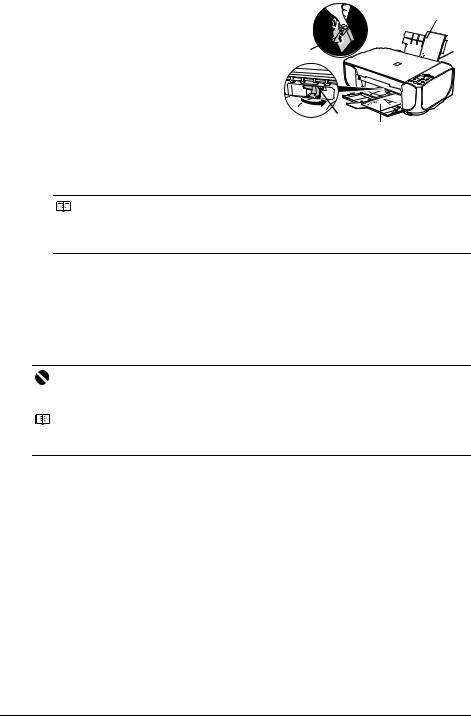
2 Load the envelopes.
(1)Load the envelope against the right side of the Rear Tray.
Load with the address side facing UP and the rear flaps DOWN on the left.
Up to 10 envelopes can be loaded at once.
(2)Pinch the Paper Guide and slide it against the left side of the envelope.
(3)Set the Paper Thickness Lever to the right.
(B)
(2)


 (1)
(1)
 (3)
(3)
(A)
(A)Printing orientation
(B)Make sure the flaps are folded.
Note
Reset the Paper Thickness Lever to the left when you finish printing. For details on the Paper Thickness Lever, refer to “Inside” in “Main Components” of the User’s Guide on-screen manual.
3 Specify the settings in the printer driver.
(1)Select Envelope in Media Type.
(2)Select the size for envelopes.
In Windows®, select DL Env. or Comm. Env. #10 in Page Size.
In Macintosh, select DL Envelope or #10 Envelope in Paper Size.
(3)Select Landscape in Orientation.
Important
Be sure to set the printer driver setting properly. If you do not, the address will be printed in the wrong direction.
Note
For details on printer driver settings, see “Printing with Windows” on page 17 or “Printing with Macintosh” on page 18.
Before Using the Machine |
13 |
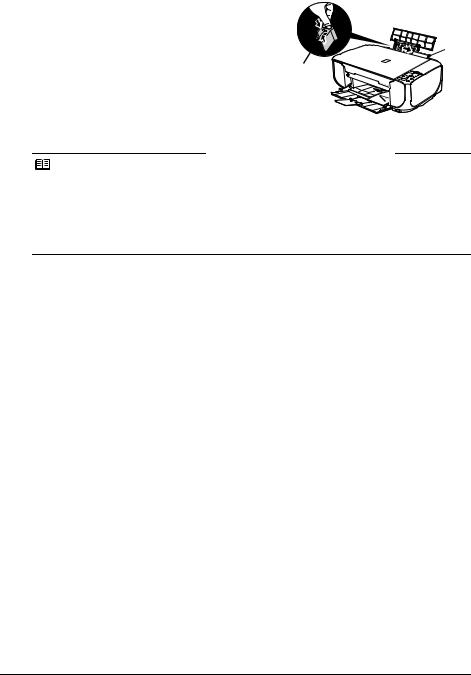
Loading Small-Sized Paper
You can use 4" x 6" / 101.6 x 152.4 mm, 5" x 7" / 127.0 x 177.8 mm, and Credit card-sized papers.
1 Load the paper.
(1) |
Load the paper against the right side of the |
|
|
|
Rear Tray with the print side facing UP. |
(1) |
|
(2) |
Pinch the Paper Guide and slide it against the |
||
|
|||
|
left side of the paper stack. |
(2) |
2 Specify the page size and media type settings according to the loaded paper.
Note
zWhen performing copy direct printing without using a computer, select the size and type of the loaded paper using the Operation Panel.
For details on settings, see “Making Copies” on page 15.
zWhen using the machine connected to a computer, select the size and type of the loaded paper in Page Size (or Paper Size) and Media Type in the printer driver.
For details on printer driver settings, see “Printing with Windows” on page 17 or “Printing with Macintosh” on page 18.
14 |
Before Using the Machine |
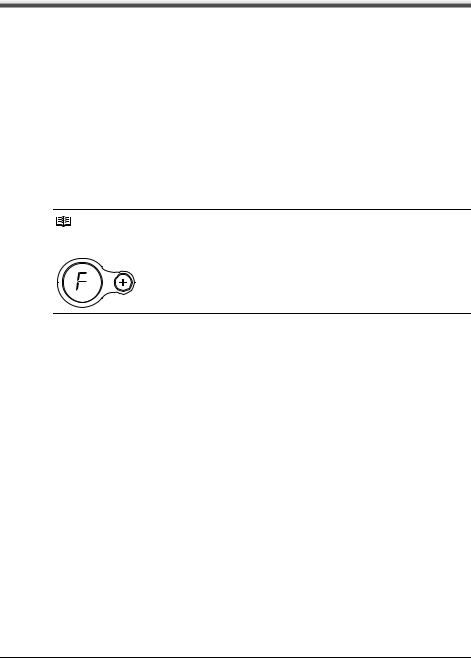
Copying
Making Copies
This section describes the basic procedure to make copies.
1
2
3
4
Turn on the machine.
See “Turning the Machine On and Off” on page 4.
Load paper.
See “Loading Printing Paper” on page 7.
Load the original on the Platen Glass.
See “Loading Original Documents” on page 6.
Specify the copy settings.
(1) Press the + button repeatedly to specify the number of copies (max. 20 copies).
Note
By pressing the + button repeatedly, F will be displayed on the LED. The number of copies will be set as 20.
(2)Press the Paper button repeatedly to specify the page size and media type. The Paper lamp indicates the selected page size and media type.
A4 or Letter Plain Paper / A4 or Letter Photo Paper / 4" x 6" Photo Paper
5 Press the Color button for color copying, or the Black button for black & white copying.
Copying 15
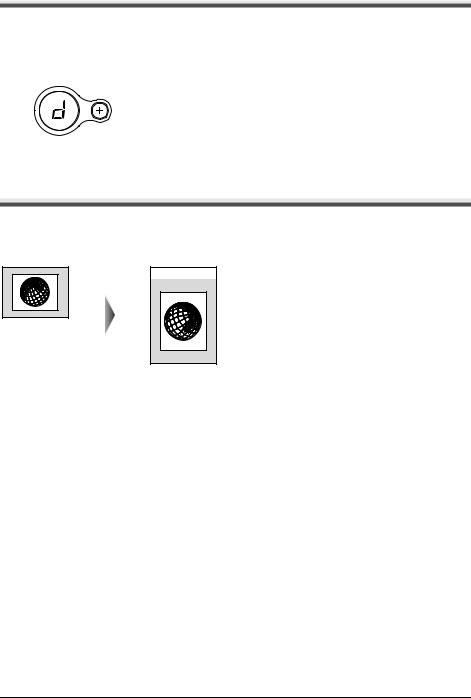
Changing the Copy Settings
Setting The Default Page Size
You can switch the size of paper loaded in the Rear Tray between A4 and Letter.
1
2
Press the Maintenance button repeatedly until d appears.
Press the Black button to select A4, or the Color button to select Letter.
Using Useful Copy Functions
For details, refer to “Fit-to-Page Copying (MP210 series)” in “Making Copies” of the User’s Guide onscreen manual.
Fit-to-Page Copying
16 Copying
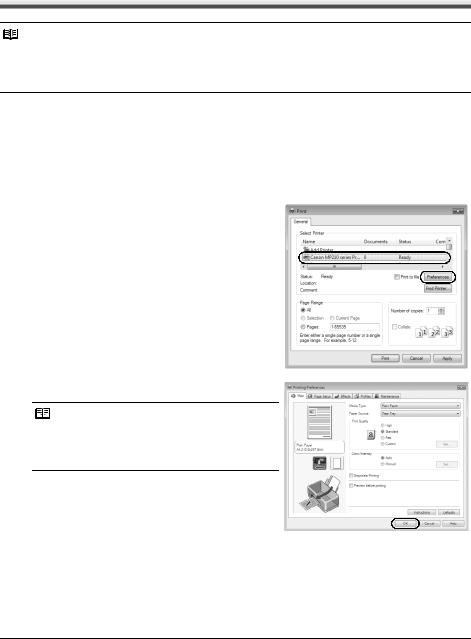
Printing from Your Computer
This section describes procedure for basic printing.
Printing with Windows
Note
Depending on your application program, operations may differ. For details, refer to the instruction manual of your application.
The steps described in this section are for printing in Windows Vista™ operating system (hereafter referred to as “Windows Vista”).
1 Turn on the machine and load the paper in the machine.
See “Turning the Machine On and Off” on page 4 and “Loading Printing Paper” on page 7.
2
3
4
5
6
Create a document or open a file to print using an appropriate application software.
Select Print on the application software’s File menu.
Make sure that Canon XXX Printer (where “XXX” is your machine’s name) is selected in
Select Printer, and click Preferences (or Properties).
Specify the required settings and click OK.
Note
For details on the printer driver functions, click Help or Instructions to view the online help or the PC Printing Guide on-screen manual. Instructions is only displayed when the on-screen manuals are installed.
Click Print (or OK).
Printing from Your Computer |
17 |
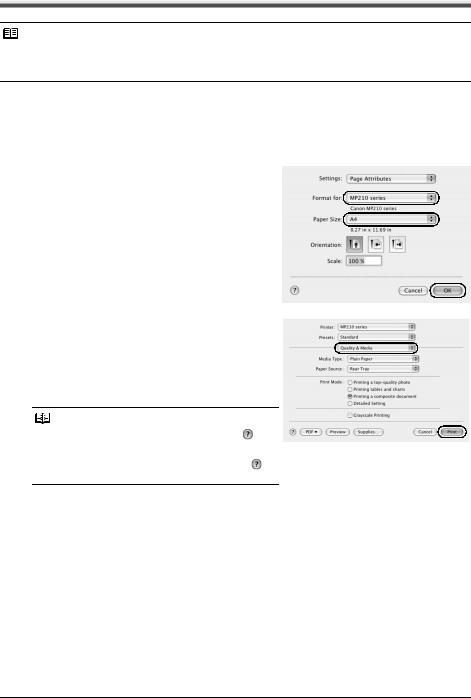
Printing with Macintosh
Note
Depending on your application program, operations may differ. For details, refer to the instruction manual of your application.
The steps described in this section are for printing in Mac® OS X v.10.4.x.
1 Turn on the machine and load the paper in the machine.
See “Turning the Machine On and Off” on page 4 and “Loading Printing Paper” on page 7.
2
3
Create a document or open a file to print using an appropriate application software.
Select Page Setup on the application software’s File menu.
4 Make sure that your machine’s name is selected in Format for.
5 Select the page size of the loaded paper in
Paper Size.
6 Click OK.
7 Select Print on the application software’s File menu.
8
9
Select Quality & Media in the pop-up menu.
Specify the required settings.
Note
For details on the printer driver functions, click to view the PC Printing Guide on-screen manual. If the on-screen manuals are not installed, the PC Printing
Guide on-screen manual is not displayed even if |
is |
clicked. |
|
10 Click Print.
18 |
Printing from Your Computer |
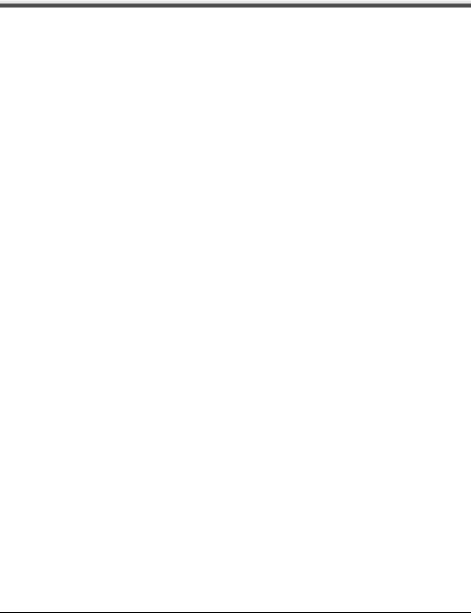
Scanning Images
You can scan images from the machine to a computer without printing them and save them in popular image types such as JPEG, TIFF, bitmaps, or PDF. If you are scanning printed text, you can use the OCR (Optical Character Recognition) software to convert it to text data.
Scanning Methods
You can select from the various scanning methods.
z If You Want to Edit or Print the Scanned Images
MP Navigator EX enables you to edit the scanned images, such as optimizing or trimming.
You can also start application software from MP Navigator EX to edit or print the scanned images.
For detailed operations of MP Navigator EX, refer to the Scanning Guide on-screen manual.
You can also use the Operation Panel to open MP Navigator EX as well as open it using the computer.
See “Opening MP Navigator EX using the Operation Panel” on page 19.
z If You Want to Scan Originals with Advanced Settings
ScanGear enables you to scan originals with advanced settings such as the resolution. For detailed operations of ScanGear, refer to the Scanning Guide on-screen manual.
Besides the above-mentioned methods, you can use a TWAINor WIA- (Windows Vista and Windows XP only) compliant application software and the Control Panel (Windows Vista and Windows XP only) to scan originals with this machine. For detailed operations, refer to the Scanning Guide on-screen manual.
Opening MP Navigator EX using the Operation Panel
1Turn on the machine.
See “Turning the Machine On and Off” on page 4.
2Load the original document on the Platen Glass.
See “Handling the Original Document” on page 6.
3Press the SCAN button.
Scanning Images |
19 |
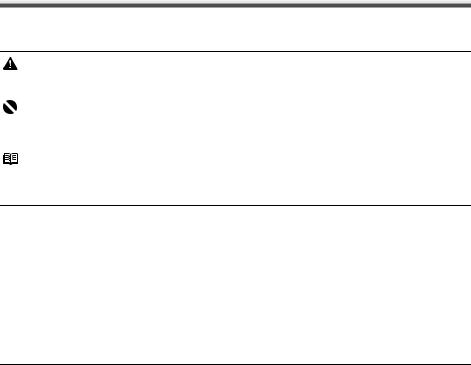
Printing Photographs Directly from a Compliant Device
You can connect a PictBridge compliant device such as a digital camera, camcorder, or mobile phone using a USB cable recommended by the device’s manufacturer, and print recorded images directly without using a computer.
z Connectable Devices
PictBridge is an industry standard enabling a range of digital photo solutions, including the direct printing of photos from a digital still camera, camcorder or mobile phone* without the need to use a computer. A device can be connected to this machine for direct printing regardless of the manufacturer or the model as long as it complies with the PictBridge standard.
*PictBridge compliant digital still cameras, digital camcorders, and camera-equipped mobile phones are hereafter collectively referred to as “PictBridge compliant device”.
 A device with this mark is PictBridge compliant.
A device with this mark is PictBridge compliant.
z Printable Image Data Format
This machine prints images taken with a DCF (Design rule for Camera File system) ver. 1.0/2.0- compatible digital camera (Exif ver. 2.2/2.21 compliant), as well as PNG files.
Printing Photographs Directly from a Compliant Device
To connect a PictBridge compliant device to this machine, use a USB cable recommended by the device’s manufacturer.
Caution
Do not connect any equipment other than PictBridge compliant devices to the Direct Print Port of the machine. If you do so, electric shock, fire, or damage to the machine could result.
Important
Never disconnect the USB cable during printing unless when explicitly allowed to by the PictBridge compliant device. When disconnecting the USB cable between the PictBridge compliant device and machine, follow the instructions given in the device’s instruction manual.
Note
When printing photos with the PictBridge compliant device connected to the machine, we recommend the use of the AC adapter supplied with the device. If you are using the device battery, be sure to charge it fully.
1 Prepare for printing.
(1)Turn on the machine.
See “Turning the Machine On and Off” on page 4.
(2)Load paper.
See “Loading Printing Paper” on page 7.
20 |
Printing Photographs Directly from a Compliant Device |
